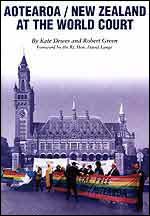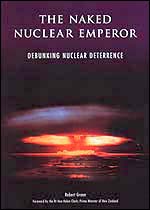Disarmament & Security Centre publications and Rob’s closing reflections Dorothy – 25/06/03
|
|
| Dr Kate Dewes |
Kate Dewes completed her PhD in 1999.Drawing upon her PhD thesis on the World Court Project, she and Rob have co-authored a booklet “Aotearoa/NZ at the World Court” to tell the story of how NZ has used the Court to challenge the legality of nuclear weapons, and of the World Court Project.
Rob emigrated to NZ in 1999, and became a NZ citizen two years later. He and Kate are working closely with the NZ government on disarmament issues.
Rob is using his military experience to promote alternative thinking about security and disarmament, and to help build bridges between the military and the peace movement. In 1998, he was commissioned to write a briefing book on the nuclear disarmament crisis, ‘Fast Track to Zero Nuclear Weapons: The Middle Powers Initiative’. This has been translated into Japanese, German and Russian. His book ‘The Naked Nuclear Emperor: Debunking Nuclear Deterrence – A Primer for Safer Security Strategies’, with a Foreword by the Rt Hon Helen Clark, NZ Prime Minister, was published in 2000. A Japanese version was published in 2001.
|
|
 |
| “The Naked Nuclear Emperor” by Rob Green | “Aotearoa / New Zealand at the World Court” by Dr Kate Dewes and Robert Green |
A booklet summarising the arguments, ‘Re-Thinking Nuclear Deterrence’, was published by the DSC in October 2001: a pdf version is available free on the DSC website. Rob is currently revising ‘The Naked Nuclear Emperor’ for a new US edition, to be published in 2004.
Closing Reflections Rob reflects on his experience of opposing the nuclear industry: “As with so many current issues, the authorities say ‘All this is too technical for the average citizen to understand. We know. Trust us.’ Jargon is used to put up a smokescreen, hiding principles which are well within the grasp of the average citizen. We need to do our own homework and become informed – and thereby to rumble the abuse of science and technology by those in power. Then we can learn to exercise citizenship, break through the deference to authority which has silenced and disempowered us, and effect change. I have learned to be a citizen, not just a subject.
“The other ploy by authorities is secrecy. How do we get the information and how do we prevent it from being suppressed? Using the Internet is one valuable way of tackling this problem.
“There is also a need for ordinary citizens to do their homework about the law, and its relation to morality and society. The other tragedy of our times has been the abuse of the law by our governments. The WCP was a classic struggle between raw power politics and the law. Its success has been an encouraging example to me of how ordinary people respond deeply to an issue combining morality and justice. It also epitomised Margaret Mead’s famous words: ‘Never underestimate the power of a small group of thoughtful, committed citizens to change the world. Indeed, it’s the only thing that ever has.’
“I believe that this is directly linked to most of the problems of the world, and especially to peace. You cannot have peace without justice, and you cannot have justice without respect for the law. The nuclear weapon issue is a catalyst for tackling the other problems. This is because the five permanent members of the Security Council are the five declared nuclear-armed nations; and they have abused the United Nations to promote their vested interests. It is high time that the UN’s own court, the International Court of Justice, is used to call them to account. Indeed, now that the Court has effectively outlawed nuclear weapons, who are the ‘rogue’ states?
“In May 1998 came the shock of India, the world’s biggest democracy, carrying out five underground nuclear tests. Pakistan, locked in a deadly struggle with India over Kashmir, responded within weeks with its own tests. Far from preventing another war between them, the following year Pakistan launched an incursion into Kargil, miscalculating that its nuclear capability would restrain India. Indeed, perhaps this was the first war to have been caused by nuclear deterrence dogma. That war, which saw both sides prepare covertly for possible use of nuclear weapons, was brought to an end by US intervention – as was a far more dangerous confrontation in 2002 following a terrorist attack on the Indian Parliament on 13 December 2001.
“Meanwhile, in 1999 NATO had intervened in the Balkans without UN Security Council approval, alienating both Russia and China, and ensuring that any more progress on nuclear disarmament would be further delayed. Furthermore, NATO refused to acknowledge that its insistence that nuclear weapons remained essential for its security had had any influence on India’s decision to become an overt nuclear power.
“Incredibly, over 30,000 nuclear weapons remain: and as the World Court reminded us, only they ‘have the potential to destroy all civilization and the entire ecosystem of the planet.’ Underlying and driving this deepening crisis in nuclear disarmament is an addiction to the doctrine of nuclear deterrence. It has now become clear that the nuclear weapon states, led by the US, UK and France, cite nuclear deterrence doctrine as the final, indispensable justification for maintaining their nuclear arsenals. Nuclear deterrence must therefore be challenged and alternatives offered if there is to be any serious prospect of eliminating nuclear weapons.
“Paradoxically, George W. Bush himself has made some encouraging statements. Over a year before the multiple terrorist atrocities of 11 September 2001 proved him right, he had become the first US President to acknowledge that nuclear deterrence is useless against what was now the primary threat to Americans: extremists armed with weapons of mass destruction (WMD). This body blow to nuclear deterrence dogma was formally endorsed in the new US National Security Strategy published in September 2002. However, the reckless solution to this dilemma has been for the US to adopt a policy of pre-emptive strikes, using nuclear weapons if necessary.
“A more potent prescription for inciting, not preventing, WMD proliferation could barely be imagined – quite apart from its assault on morality and international humanitarian law.
“Even so, the demonology of nuclear deterrence lives on. After Presidents Bush and Putin signed the Strategic Offensive Reductions Treaty in Moscow in May 2002, and declared that this heralded a new era where Mutual Assured Destruction had been replaced by mutual co-operation, the US and Russia continue to keep a combined total of 4,000 strategic nuclear weapons, with a destructive capacity equivalent to 80,000 Hiroshima bombs, ready to be launched within minutes.
“Although a vast literature exists on the subject of nuclear deterrence, it is discursive, fragmented and academic. Many powerful arguments are buried deep in inaccessible volumes. To my knowledge, no attempt has been made since the end of the Cold War to draw together, in a concise form, a comprehensive critique of nuclear deterrence doctrine and safer alternative approaches to achieving security. That is why I wrote my book ‘The Naked Nuclear Emperor: Debunking Nuclear Deterrence’.”






